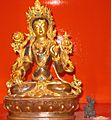Tara (Buddhism) facts for kids
Tārā, also known as Jetsun Dolma in Tibetan, is a special female Buddha in Tibetan Buddhism. She is often called the "mother of freedom" because she helps people achieve their goals. Tārā represents success and good achievements.
Followers of Tibetan Buddhism use practices related to Tārā to grow their inner kindness and understanding. She helps them learn about compassion and other important Buddhist ideas. Tārā is not part of the Japanese type of Buddhism called Shingon.
There are many different forms of Tārā. Each form shows a different good quality or aspect of her wisdom. Think of them like different ways to understand the same helpful idea.
Different Forms of Tārā
Tārā appears in many forms, each with its own special meaning:
- Green Tārā: She is known as the Buddha of enlightened activity. This means she helps people take action and get things done.
- White Tārā: She is linked with compassion, long life, healing, and peace. She is also called "The Wish-fulfilling Wheel."
- Red Tārā: This form looks strong and powerful. She is connected with attracting good things into your life.
- Black Tārā: She is associated with power and strength.
- Yellow Tārā: This form is linked to wealth and prosperity, helping people find good fortune.
- Blue Tārā: She helps change anger into wisdom.
- Cittamani Tārā: This is a green form of Tārā, often seen as the same as Green Tārā, and is important in the Gelug school of Tibetan Buddhism.
- Khadiravani Tārā: Also called Tārā of the teak forest. She is said to have appeared to a wise teacher named Nagarjuna in a forest in India.
In some Buddhist traditions, there are twenty-one different Tārās. A special prayer called In Praise of the 21 Tārās is often said in the morning by people who follow Tibetan Buddhism.
Tārā's Mantra
The main chant or mantra for Tārā is Oṃ tāre tuttāre ture svāhā. In Tibet and by many Buddhists, this Sanskrit mantra is said as Oṃ tāre tu tāre ture soha. Saying this mantra is a way to connect with Tārā's qualities and ask for her help.
Images for kids
-
Famous Holy Spoken Green Tara in Nyanang Phelgyeling Monastery, Nepal.
-
18th-century Eastern Tibetan thanka, with the Green Tara (Samaya Tara Yogini) in the center and the Blue, Red, White and Yellow taras in the corners, Rubin Museum of Art
-
Tara statue near Kullu, Himachal Pradesh, India.
See also
 In Spanish: Tara (budismo) para niños
In Spanish: Tara (budismo) para niños















